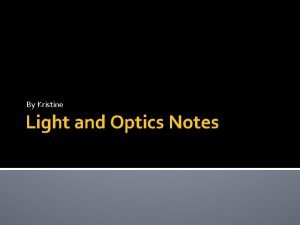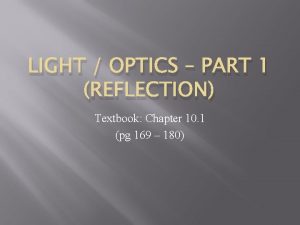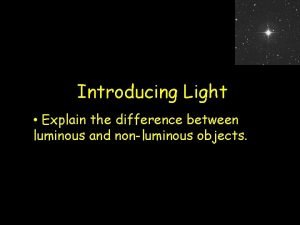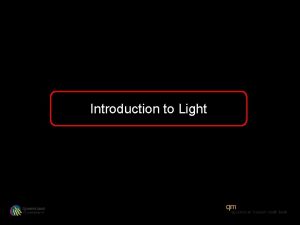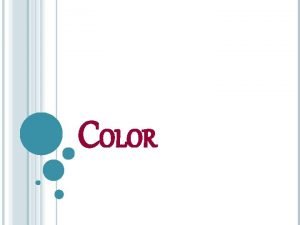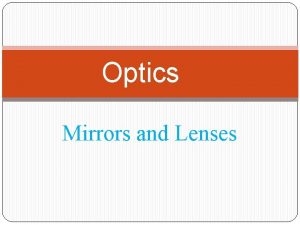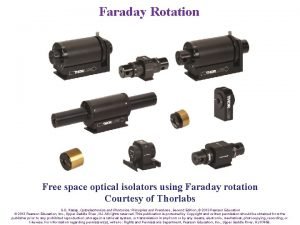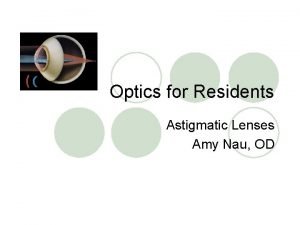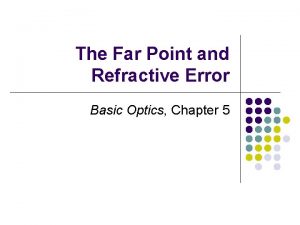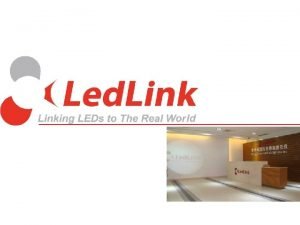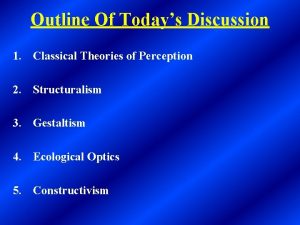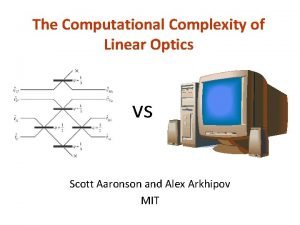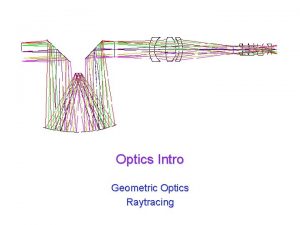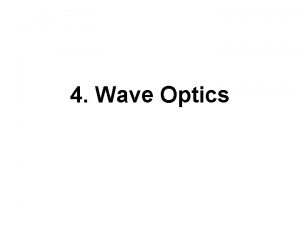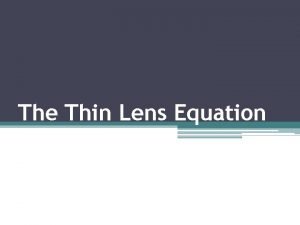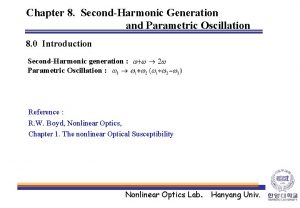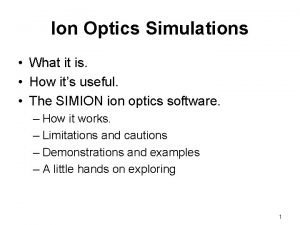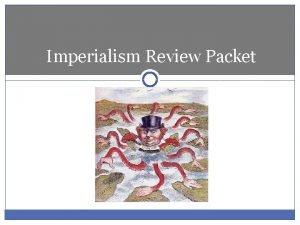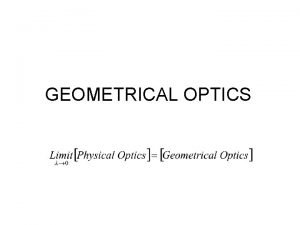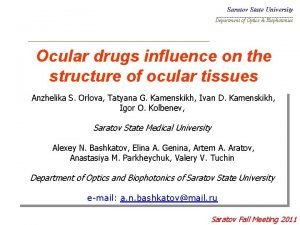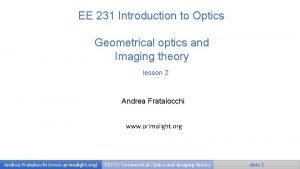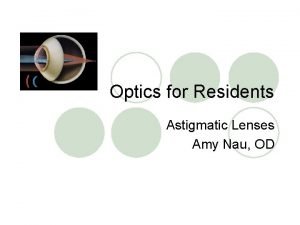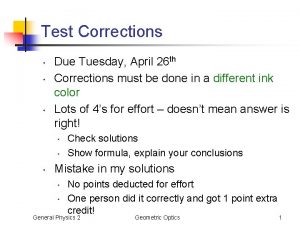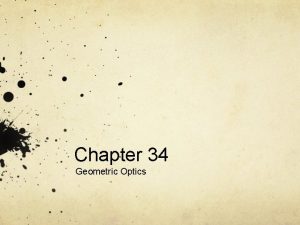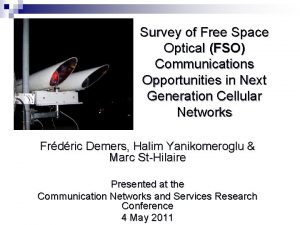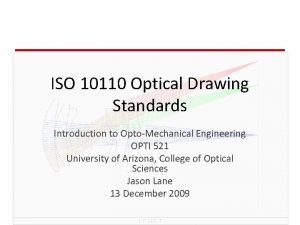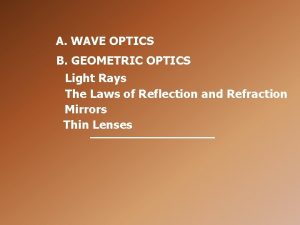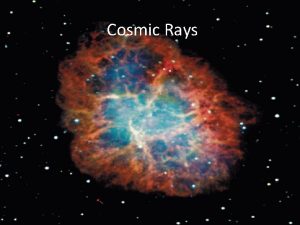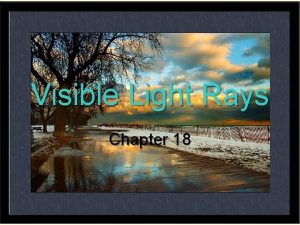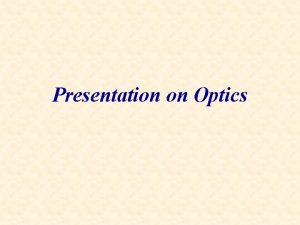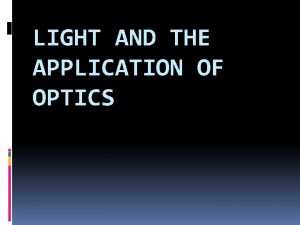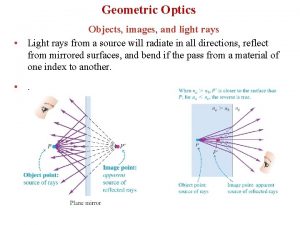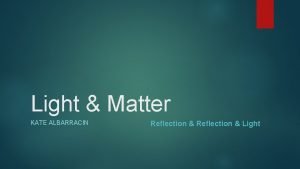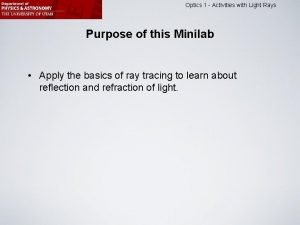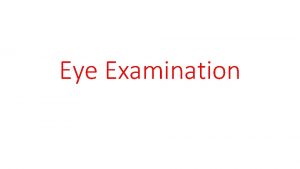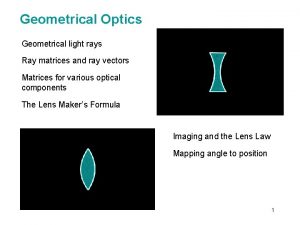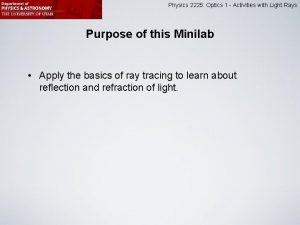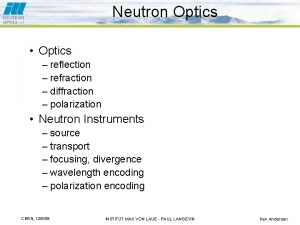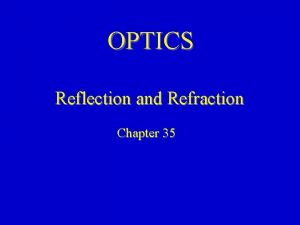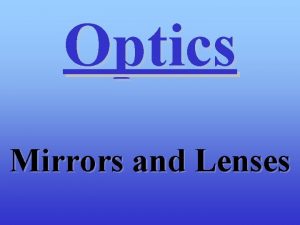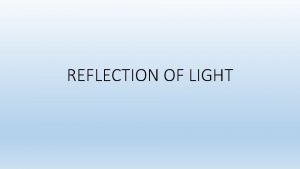Optics 1 Reflection of Light Reflection Light rays






































- Slides: 38

Optics 光學 1. Reflection of Light

Reflection (反射)

Light rays Light is a source of energy. We detect it with eyes.

Experiment : Reflection by plane mirrors • Aims: • Study the reflection of light rays by a plane mirror and also find out how to locate the image formed by a plane mirror.


Experiment 1. 1 Law of Reflection 1. Direct a ray of light at a plane mirror as shown. Ray-box normal Plane mirror

Experiment 1. 1 Law of Reflection 1. Direct a ray of light at a plane mirror as shown. Angle of incidence (入射角) i of the light ray Angle of reflection (反射角) r

Experiment 1. 1 Law of Reflection 1. Direct a ray of light at a plane mirror as shown. 2. Measure the angle of incidence and the angle of reflection.

Experiment 1. 1 Law of Reflection 1. Direct a ray of light at a plane mirror as shown. 2. Measure the angle of incidence and the angle of reflection. 3. Repeat several times by changing the anlge of incidence.

3. Repeat by changing the angle of incidence. Record the results. Angle of incidence i Angle of reflection r 0 10 20 30 40 50 How is the angle of incidence related to the angle of reflection? ______________________________

How is the angle of incidence related to the angle of reflection?

The angle of reflection is equal to the angle of incidence.

Laws of reflection : There are two laws of reflection 1. The incident ray, the reflected ray and the normal all lie in the same plane. This means that all three can be drawn on a flat sheet of paper 2. The angle of incident (i) is equal to the angle of reflection (r). The ray is reflected from the mirror at the same angle as it arrives.

Example 1. (a) What is the angle of incidence? The angle of incidence = 40° (b) Complete the following ray diagram by drawing all the reflected rays. (c) What is the relation between the original incident ray and final reflected ray They are parallel. Plane mirror 50° 40° 50° Plane mirror 40°

Arrange light rays to hit the plane mirror as shown in figure. Study how the rays are reflected. Look at the rays from above. Also bend down and look along the rays behind The reflected rays seem to come from a point _____ (in front of / behind) the mirror.








Conclusion: 1. In reflection, the angle of incidence is equal to the angle of _________. reflection 2. An image formed by a plane mirror is as far behind the mirror as the object is ______. abc perpendicular 3. The line joining the object and the image is _______ to the mirror.

Laws of reflection


Object Image

Object Image

Object Image

Complete the rays and located the image Object Image

A man 1. 8 m tall stands in front of a plane mirror. His eyes are 1. 7 m Above the ground. (a) What is the minimum length of a mirror that allows him to see his whole body? (b) At what height should the mirror be hung? Man Eye Image

A man 1. 8 m tall stands in front of a plane mirror. His eyes are 1. 7 m Above the ground. (a) What is the minimum length of a mirror that allows him to see his whole body? (b) At what height should the mirror be hung? Man Eye Image

A man 1. 8 m tall stands in front of a plane mirror. His eyes are 1. 7 m Above the ground. (a) What is the minimum length of a mirror that allows him to see his whole body? (b) At what height should the mirror be hung? Man Eye Image

A man 1. 8 m tall stands in front of a plane mirror. His eyes are 1. 7 m Above the ground. (a) What is the minimum length of a mirror that allows him to see his whole body? (b) At what height should the mirror be hung? Image 0. 9 m 1. 8 m (a) Minimum length = 0. 9 m There are two similar triangles

A man 1. 8 m tall stands in front of a plane mirror. His eyes are 1. 7 m Above the ground. (a) What is the minimum length of a mirror that allows him to see his whole body? (b) At what height should the mirror be hung? Man Eye Image

A man 1. 8 m tall stands in front of a plane mirror. His eyes are 1. 7 m Above the ground. (a) What is the minimum length of a mirror that allows him to see his whole body? (b) At what height should the mirror be hung? Man Eye Image

A man 1. 8 m tall stands in front of a plane mirror. His eyes are 1. 7 m Above the ground. (a) What is the minimum length of a mirror that allows him to see his whole body? (b) At what height should the mirror be hung? Man Eye There are two similar triangles 1. 7 m (b) It should 0. 85 above the ground 0. 85 m

Object

Uses of plane mirrors 1. To help use look at ourselves, 2. To make a room look bigger, 3. In periscopes
 Difference between ray optics and wave optics
Difference between ray optics and wave optics Reflection and refraction venn diagram
Reflection and refraction venn diagram Bill nye light energy
Bill nye light energy Light and optics notes
Light and optics notes Single ray
Single ray Examples of non luminous object
Examples of non luminous object Why can we represent light rays using a ruler
Why can we represent light rays using a ruler The visual response of the eye to reflected rays of light
The visual response of the eye to reflected rays of light Identifying materials that block light
Identifying materials that block light Chapter 22
Chapter 22 Light light light chapter 23
Light light light chapter 23 Into the light chapter 22
Into the light chapter 22 Plano convex lens
Plano convex lens Nonlinear optics
Nonlinear optics Turba optics
Turba optics Maddox rod
Maddox rod Far point optics
Far point optics Optics plural or singular
Optics plural or singular Dogguan
Dogguan Gestaltism
Gestaltism The computational complexity of linear optics
The computational complexity of linear optics Optics
Optics Fourier optics
Fourier optics Formula of thin lens
Formula of thin lens Phys 241 purdue
Phys 241 purdue Purtubation
Purtubation Ion optics simulation
Ion optics simulation Optics
Optics Geometrical
Geometrical Laws of optics
Laws of optics Http //www.phys.hawaii.edu/ teb/optics/java/slitdiffr/
Http //www.phys.hawaii.edu/ teb/optics/java/slitdiffr/ Optics
Optics Types of optics
Types of optics Airy disk resolution
Airy disk resolution Interval of sturm
Interval of sturm Geometric optics
Geometric optics Convergin lens
Convergin lens Free space optics
Free space optics Iso 10110
Iso 10110



